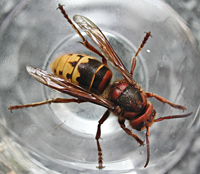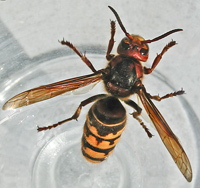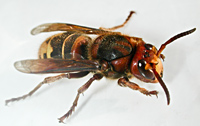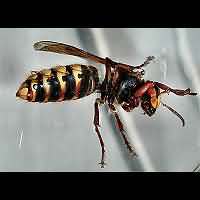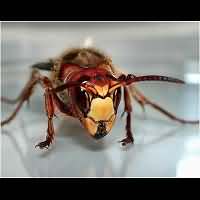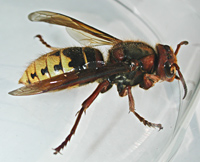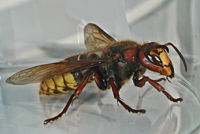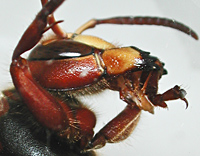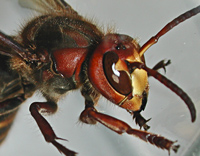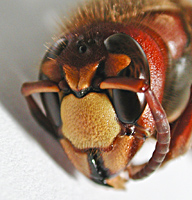[All pictures of garden wildlife on this page are thumbnails. Click on any thumbnail for a large format to be displayed.]
Hornet (Vespa crabro)
The Hornet is our biggest Yellow Jacket. It is an impressive wasp with distintive black with yellow stripes on the abdomen. The stripes on head and thorax are reddish brown. The first part of the abdomen may also be partly reddish brown. The similar Red Wasp often has a partly reddish abdomen as well, but it is much smaller and the stripes on thorax and head are always yellow, never brownish. Another similar Median Wasp has reddish stripes on the thorax, but the markings on head and abdomen are always yellow. And what's more: the Median Wasp always gives the impression of being darker than the other Yellow Jackets. One other feature makes the Hornet stand out in comparison to its smaller nephews: the head and abdomen are rather plump. Workers grow to a bodily length of 18 to 25mm. Males are slightly bigger: 21 to 28mm. Queens however are very telling, for they reach a length of 25 to 36mm!In April and the beginning of May you may get to see the Hornet queen. It is the period of time when it is searching fot the suitable location for the nest.Usually the nest is made in a conspicuous place like a hollow tree or a nesting box. Sometimes the nest is constructed underground. Rarely it is hung openly in a tree or in a shrub. The nest may be some 60cm long and is of an ochreous or light brown colour. On the outside are a number of clam-shaped air chambers. The nest contains 4 up to 12 combs. At the peak of its development the nest contains some 1,700 animals, including eggs, larvae and pupae. The development of a hornet takes quite some time and the first males and new queens do not appear before the end of August.
Of all Paper Wasps the Hornet is the only species to hunt both at night and by day. While hunting at night they are regularly attracted to prey flying near a lamp. This usually causes great comotion and - obviously - the lamp owner is not happy with such events taking place. The sting of the Hornet is quite painful, but the species is not aggressive at all. Their nests should be approached outmost caution as the your presence is very likely to trigger their anger. But even then a Hornet will not sting you quickly and it will usually try to chase you away by hovering in front of you. Just take a few steps aside (do not move forward or backwards) to move from the straight lane to the nest and suddenly the Hornet disappears. Hornets do like fallen and rotting fruit in autumn, but they will hardly ever bother us sitting on a terrace like Yellow Jackets do. The animals are very important to us for they kill lots of other insects. And because it is quite a huge animal it is capable of attacking larger insects than most other wasps. The Hornet has a remarkable habit, the larvae produce a sweet milk used to feed on by the adults. Similar to all other wasps, the adults do not live on flesh but on nectar. The young eat the prey collected by the adults and secret nectar-like fluid themselves on which the parents feed.
The Hornet used to be quite common in England in the past but numbers declined dramatically in the 50's and 60's. However since 1990 numbers increase again and the Hornet is seen in southern parts of England up to the Midlands. It is still quite rare though.

© Copyright 1998-2024 gardensafari.net (Hania Berdys)

 English / engels
English / engels  Dutch / nederlands
Dutch / nederlands